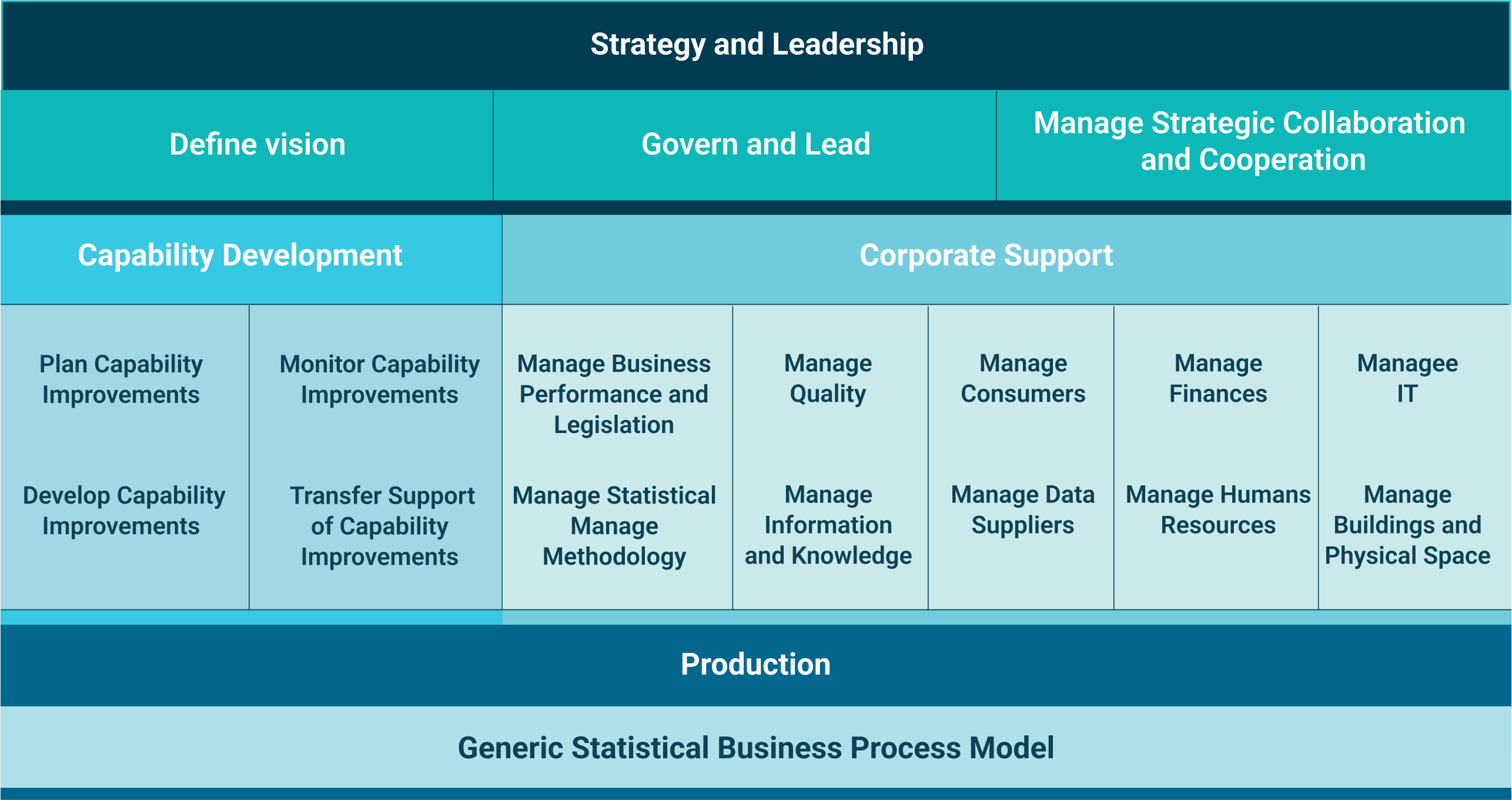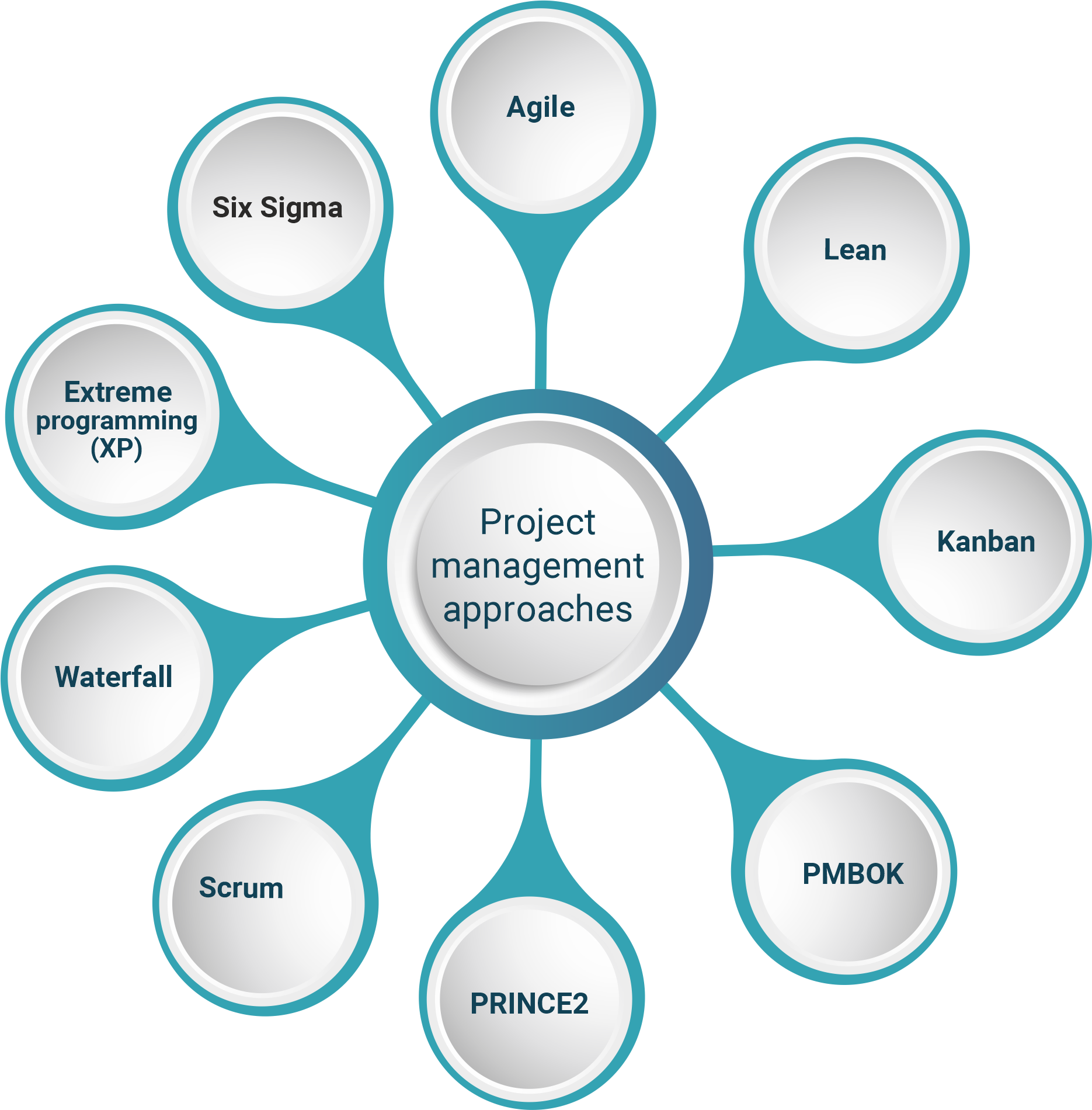5.5 Statistical Business Architecture
5.5.1 Definition of a Statistical Business Architecture
A statistical business architecture covers all of the activities undertaken by an NSO to conceptualize, design, build and maintain information and application resources used in the production of statistical outputs. It is a formalized collection of practices, information, and tools to assess and implement business design and business change.
It consists of the information, application and technology architectures for a statistical organization. The information architecture describes the information, its flows and uses across the organization, and how that information is managed; the application architecture describes the set of practices used to select, define or design software components and their relationships. The technology architecture describes the infrastructure technology underlying and supporting the information and application architectures.
5.5.2 The need for a Statistical Business Architecture
Business architectures focus on business processes, and business uses cases, which are prerequisites to delivering an IT business solution. Therefore, the business architecture must reflect the entire business design from the business itself rather than that of the IT solution.
Business architecture represents a bridging function between the enterprise architecture level and the operational level and supports an integrated and ordered implementation of all the innovations necessary for any modernisation process.
The statistical business landscape can change rapidly, as in any other business. To stay relevant during such changes, the business needs to adopt a new model that allows it to adapt accordingly – and for this, agile business architecture is needed.
The agile method is a particular approach to project management utilized in software development and allows organizations to respond to the unpredictability of developing software solutions. It uses incremental, iterative work sequences that are commonly known as sprints.
The agile model uses assessments to determine what capabilities are available in the organization, identifies what is needed to pull the appropriately skilled staff, processes, and technology together. It uses small experiments to promote quick learning and allows an organization to quickly adapt through decentralized decision making.

■ A Business Architecture framework for industrialisation and standardisation in a modern National Statistical Institute ().
5.5.3 The Common Statistical Production Architecture
Business architecture includes elements of the information, application and technology architectures.
CSPA has been developed in recent years by the international statistical community under the auspices of the High-Level Group for the Modernisation of Official Statistics (HLG-MOS).
CSPA is a framework for developing statistical processing components reusable across projects, platforms and organizations - it is often referred to as ‘plug and play’. A formally defined business architecture can reference CSPA.
CSPA is covered in more detail in Chapter 14.2.12 — Common Statistical Production Architecture (CSPA).

■ Definition of a business architecture () from HLG-MOS.
5.5.4 The Generic Activity Model for Statistical Organizations
The Generic Activity Model for Statistical Organizations (GAMSO) is the model covering activities at the highest level of the statistics organization. It describes and defines the activities that take place within a typical organization that produces official statistics.

GAMSO was launched in 2015 and extends and complements the Generic Statistical Business Process Model (GSBPM) by describing overarching and cross-cutting activities that are needed to support statistical production. It is part of the common vocabulary of collaboration.
The GAMSO standard covers four broad areas of activity within an NSO: production; strategy and leadership; capability management; and corporate support. As with related international standards, GAMSO contributes towards creating a common vocabulary for these activities and a framework to support international collaboration activities, particularly in the field of modernisation. It can be used as a basis for resource planning within an NSO. GAMSO can contribute to the development and implementation of enterprise architectures, including components such as capability architectures, and also support risk management systems.
GAMSO is also covered in Chapter 14.4.2 — Generic Activity Model for Statistical Organizations (GAMSO).

■ A description of the GAMSO () and how it relates to other key standards for statistical modernisation.
5.5.5 Definition of an integrated production system
In recent years, many NSOs have initiated developments to restructure their statistical production processes, improve efficiency, and produce outputs that better satisfy user needs. These developments manage the evolution from the classic insular ‘silo’ approach, where specific domains have their own customised processes and architecture to a more integrated and modular approach where processes are shared and reused.
An integrated system enables an NSO to transition from a fragmented stove-pipe oriented production with specific systems for each domain, to the modern generic and standardised statistical production environment. A fully integrated system uses applications and processes that use standards and metadata to talk to each other in order to make the whole production cycle less burdensome, easier to manage and less expensive to operate.
5.5.6 Importance of an integrated production system
There are a number of reasons for an NSO to adopt an integrated production approach.
An integrated production system can help reduce the time, cost, and risk-related barriers for implementing innovations in statistical production processes by working in a more efficient and optimised way. NSOs constantly need to improve the production of statistical information and its quality, while simultaneously reducing both the total cost for its production and the respondent burden.
In a silo-based production system, each specific domain has its own set of custom processes that lead to duplication of effort and other inefficiencies. There is often a lack of common terminology and understanding across applications and a lack of process-orientation. Because of these differences, such production systems are difficult to modernise and automate, and it is difficult to reuse information, methods, and technology. Together these difficulties result in a lengthy time-to-market for new statistical products.
An integrated production system involves the development and application of common methods and information technologies. This approach leaves freedom of choice in regard to underlying technologies and is a key enabler for collaborating, sharing and the flexible re-use of IT components within individual agencies and across the community of producers of official statistics as a whole: new statistical production processes can be assembled by selecting and configuring existing modules (also more widely known as ‘plug and play’) in using whatever applications (or parts thereof) that best respond to their particular requirements.

■ Example from Slovenia NSO of transition from stove-pipe oriented production to an integrated processing system ().
■ Example from Korea NSO of the development of a generic Statistical Information System ().
■ Example from Statistics South Africa of using innovative technologies for statistical production ().
5.5.7 Project management approaches
In any given NSO, there will almost always be several projects relating to methodological development of statistics and modernisation of production processes and systems. Depending on the methods used and the scale of a given project, several different project management strategies and methodologies can be adopted. Some of the most widely used and emerging approaches are described below.

■ Agile project management is based on a set of principles and consists of a flexible, iterative design and building process. Agile projects are characterized by a series of conceived, executed, and adapted tasks as the situation demands, rather than by a pre-planned process. This helps project teams respond to unpredictability through incremental, iterative work processes and a cycle of planning, executing, and evaluating as they go along. Agile methodologies emphasize adaptability to changing situations and the potential for changing or evolving requirements, such as software and game development.
■ Lean is a project management methodology focused on efficiency and eradicating inefficiency by removing anything from the process that is not conclusively adding value to the client. Lean originated in manufacturing to eliminate waste and inefficiency, but its principles can be applied to any process. Examples of waste are defined as excessive documentation, planning and control, unproductive meetings and overly detailed requirements.
■ Kanban is a project management methodology based on lean principles with a focus on releasing early and often with a collaborative and self-managing team. It is fitted for operational or maintenance environments where priorities can change frequently. Kanban is well-suited to work that requires steady output, like production or support and maintenance.
■ PMBOK (Project Management Body of Knowledge) is a reference guide for project managers covering a set of standards which refer to the five process steps of initiating, planning, executing, controlling, and closing a project. PMBOK is a framework of standards, conventions, processes, best practices, terminologies, and guidelines recognised as standards within the project management industry. PMBOK is formulated around processes that coincide and impact each other to complete a project.
■ PRINCE2 (Projects IN Controlled Environments) is a well-established process-oriented project management methodology. It divides projects into multiple stages, each with their own plans and processes to follow. PRINCE2 defines inputs and outputs for every stage of a project and stresses the business motives such as identifying a clear need for the project, target customers, benefits, and cost assessment. A project board owns the project and is responsible for its success. This board defines the structures for the team, while a project manager oversees the lower-level day-to-day activities. This methodology gives teams greater control of resources and the ability to mitigate risk effectively. PRINCE2 is widely used for large scale IT projects.
■ Scrum is a project management process which proposes principles and processes to improve delivery. It is one of many agile processes and aims to improve communication, teamwork and speed of development. Scrum is considered a light approach to project management and defines a simple set of roles, meetings, and tools to deliver outputs iteratively and incrementally. It recommends using small, cross-functional teams working on a collection of requirements (‘user stories’) that have been defined and prioritized by a product owner. Work is divided into ‘sprints’, a development cycle of usually 2-4 weeks, during which, daily ‘scrums’ take place where the team report on progress and obstacles.
■ Waterfall is a project management methodology where work is planned extensively upfront and then executed, in strict sequence, adhering to requirements, to deliver the project in a single cycle. Requirements are defined in full before any work starts. Project tasks cascade through subsequent phases of the project each phase must be completed before the next phase can begin and there is no overlapping in the phases, and the outcome of one phase acts as the input for the next phase. In a waterfall approach, a project will flow through the process from requirements, through design, implementation, testing and into maintenance. Once a project plan is approved, there is little flexibility to make any changes.
■ Extreme programming (XP) is a software development project management methodology which defines values and processes to improve software quality and ensure responsiveness to evolving customer requirements. As a type of agile software development, it advocates frequent "releases" in short development cycles intended to improve productivity. XP includes elements such as programming in pairs, extensive code reviews, unit testing of all code, a flat management structure, expecting changes in the customer's requirements and frequent communication with the customer and among programmers.
■ Six Sigma methodology focuses on understanding customers' requirements better and eliminating defects and waste. These objectives are achieved through in-depth knowledge of statistics, engineering, project management, and the underlying processes and systems. Six Sigma aims to identify and remove the causes of defects via a set of quality management methods, which use both empirical and statistical approaches – unlike in other methodologies data and statistics are the basis of decision-making rather than assumptions or guesses.